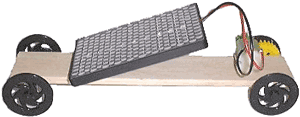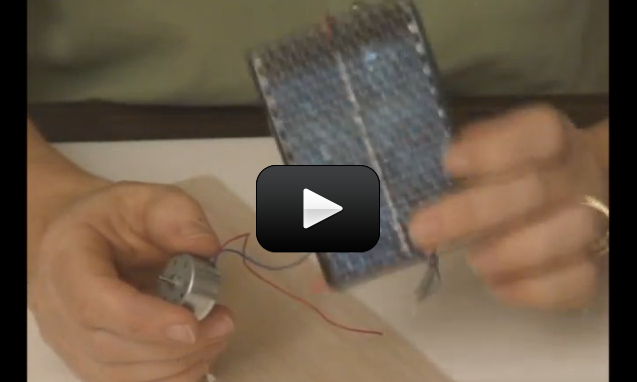 Solar energy (power) refers to collecting this energy and storing it for another use, like driving a car. The sun blasts 174 x 1015 watts (which is 174,000,000,000,000,000 watts) of energy through radiation to the earth, but only 70% of that amount actually makes it to the surface. And since the surface of the earth is mostly water, both in ocean and cloud form, only a small fraction of the total amount makes it to land.
Solar energy (power) refers to collecting this energy and storing it for another use, like driving a car. The sun blasts 174 x 1015 watts (which is 174,000,000,000,000,000 watts) of energy through radiation to the earth, but only 70% of that amount actually makes it to the surface. And since the surface of the earth is mostly water, both in ocean and cloud form, only a small fraction of the total amount makes it to land.
A solar cell converts sunlight straight into electricity. Most satellites are powered by large solar panel arrays in space, as sunlight is cheap and readily available out there. While solar cells seem ‘new’ and modern today, the first ones were created in the 1880s, but were a mere 1% efficient. (Today, they get as high as 35%.) A solar cell’s efficiency is a measure of how much sunlight the cell converts into electrical energy.
We’re going to use solar cells and the basic ideas from Unit 10 (Electricity & Robotics) to build a solar-powered race car. You’ll need to find these items below. Note – if you have trouble locating parts, check the shopping list for information on how to order it straight from us.
- Solar cell
- Solar motor
- Foam block (about 6” long)
- Alligator clip leads
- 2 straws (optional)
- 2 wooden skewers (optional)
- 4 milk jug lids or film can tops
- Set of gears, one of which fits onto your motor shaft (most solar motor kits come with a set), or rip a set out of an old toy
Here’s what you do:
Please login or register to read the rest of this content.


It’s included in our Science Mastery Diamond program, however you can purchase the solar cell and motor using the order links in the shopping list, and substitute milk jug lids for wheels and find balsa wood at any craft/hobby shop.
how do you get the kit?
cool
wow just wow!
PV energy was first discovered/invented in 1839, but weren’t practically developed for energy purposes until halfway through the 20th century. Since the 1950s and 60s, research and materials have improved to
help mass produce the more efficient and widespread PV cells that we see.
PV cells essentially involve the interaction of photons (light particles) and a semiconducting material, in most cases silicon. When a photon hits the silicon on a PV cell, some electrons are knocked loose and a current can flow because of the difference in electrons from one material to the next (called electric potential difference). If you want to know more, you can read about it here
<http://science.nasa.gov/science-news/science-at-nasa/2002/solarcells
Question: When did solar cell technology develop? and How does photovoltaic
(PV) technology work?
awesome car!!!!!
Yep – did you get mine?
Did you get the email?
Right – that’s an advanced project for folks that have the K-12 level of e-Science. Go ahead and send over what you have and we’ll take a peek. If you ever want to upgrade your enrollment, just give a whistle and we’ll help.
The one I don’t have access to is the advanced project with this link:https://www.sciencelearningspace2.com/2010/05/fuel-cell-power/ and I’ll send you the schematics right away.
Sure – send them over to us at: [email protected] and we can take a peek. This isn’t something we cover in our program, so we’ll do our best.
Also – is there something you’re wanting access to? I am unclear as to which experiment you’re interested in – I don’t have any solar-cells-charging-batteries experiments posted. The Fuel Cell vehicle uses the PEM and solar cell for electrolysis, not battery charging.
I was going to charge two AAs directly by the solar panel. Also I made a solar cell phone charger, could I use the same circuit (except where the DC to USB converter is the motor would be)? I would do the other one you recommended but I don’t have access to it. Can i send you the schematics by email or another way?
Great pic!
How do you want to use your batteries in the circuit? If you want to charge them through the solar cell, you need a special kind of circuit and re-chargable batteries (regular alkalines are not going to work). I couldn’t find any that were easy enough to do with simple materials, or I’d post it here. However, I do have a circuit in Unit 12 Lesson 2 that outlines how to run a car on sunlight and water using a solar cell and a fuel cell together: https://www.sciencelearningspace2.com/2010/05/fuel-cell-power/ It’s an advanced project, though…
If i wanted to add a battery pack so the solar cell charged the batteries which ran the motor, how would I fit it in the circuit?
Radio shack sells (or perhaps used to?) a motor-solar cell pack. Occasionally, the places we recommend purchasing things from change their offerings, so we try to keep the info updated for you. Use the radio shack numbers to order the kit online, or simply find yourself a solar motor and cell paired together to make this project – it doesn’t have to be from Radio Shack or us, most motors and solar cells will work. 🙂
The solar car kit we have does include a four gear set. If you purchased it from us, and we made a mistake, just let me know and we’ll ship those right out to you. The radio shack kit does not include the gears, which is why it’s listed separately on the material list for this project.
The kit you tell us to get does not come with gears.
what kit??